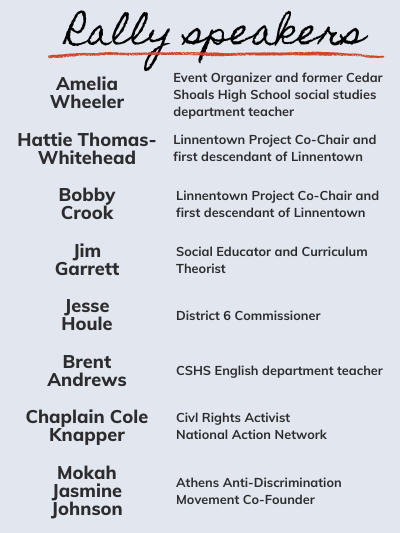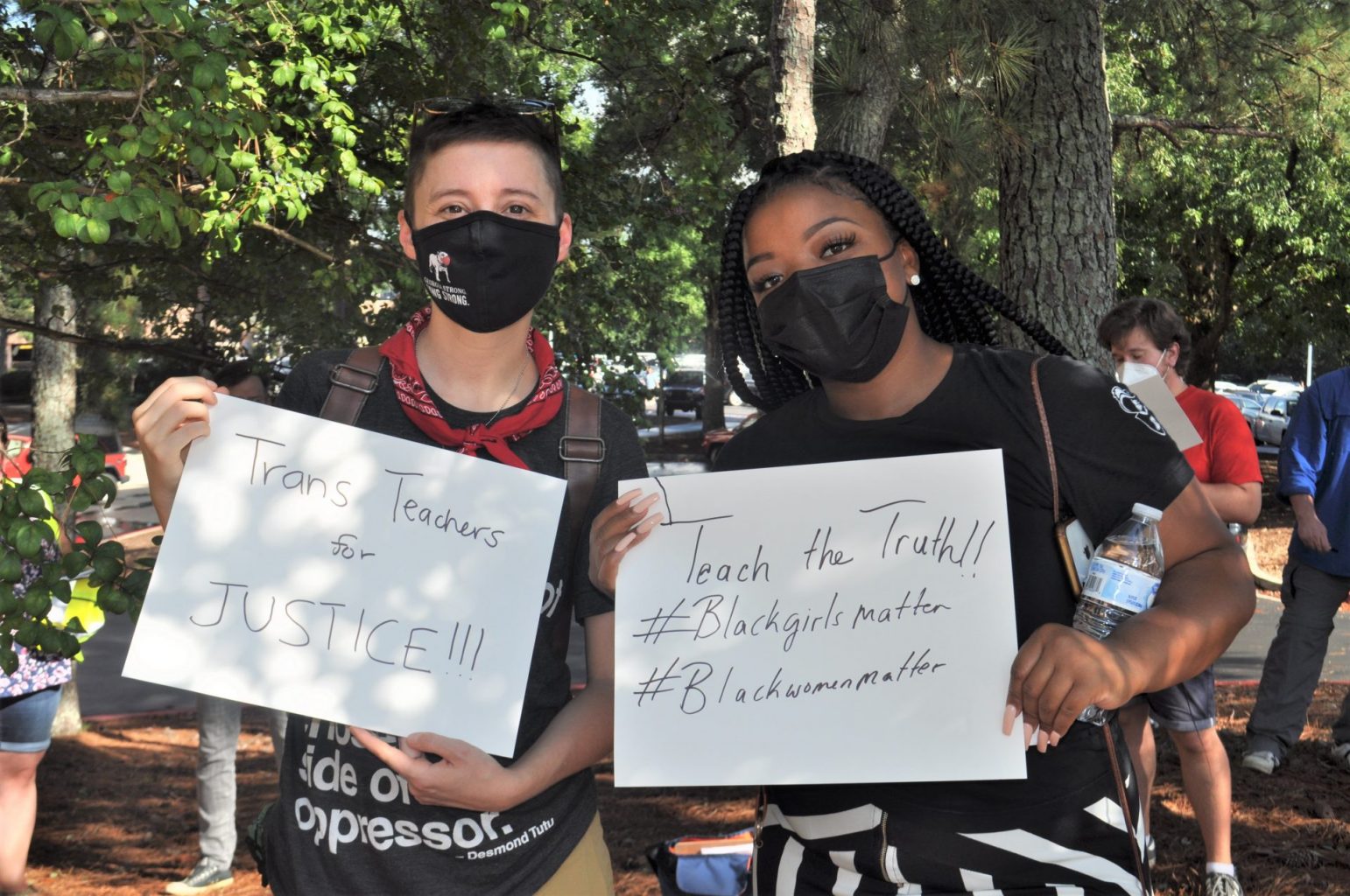Linnentown first descendant and Linnentown Project Co-Chair Hattie Thomas Whitehead speaks at the Pledge to Teach Truth Rally on Aug. 27. The Pledge to Teach Truth Rally was held at the University of Georgia’s Brumby Hall, the site where Linnentown once stood. “I’m a first descendant of Linnentown and I was a speaker (at the rally), and I wanted it to be here so people could understand that this was the land that was taken from (Linnentown residents),” Thomas Whitehead said. Photo by Maya Clement
The Pledge to Teach Truth Rally took place at UGA’s Brumby Hall on Aug. 27 in partnership with the Linnentown Project to educate people on and bring awareness to local civil rights history and education.
Teachers, students and activists gathered together at Brumby Hall off of Baxter Street on Aug. 27 for the Pledge to Teach Truth Rally. Attendees came to advocate for teachers bringing discussions of local civil rights history and critical race theory into the classroom.
The rally was part of a nationwide campaign coordinated by the Zinn Education Project to raise public awareness about proposed anti-critical race theory legislation in 28 states, including Georgia. In Athens, the Pledge to Teach Truth Rally organizers partnered with the Linnentown Project to bring attention to local civil rights history and push for discussions of Linnentown in CCSD classrooms.
“I was deeply troubled by these (legislative) attacks on teachers’ ability to teach the truth. I wanted teachers to know that they weren’t alone and I wanted young people to know their teachers care about them,” event organizer and former Cedar Shoals High School social studies department teacher Amelia Wheeler said. “I wanted to bring teachers and students and activists here together to say that we are going to teach the truth (and) we know it’s important.”

An infographic shows the speakers at the Pledge to Teach Truth Rally. Linnentown Project Co-Chair and First Descendant of Linnentown Bobby Crook was one of the speakers at the rally and talked about his childhood in Linnentown. “You have to know where you come from in order to know where you’re going, and history shouldn’t be hidden,” Crook said. “That’s the knowledge that we need to know in order to move forward.” Infographic by Natalie Schliekelman
Wheeler coordinated the event with the help of Linnentown first descendant and Linnentown Project Co-Chair Hattie Thomas Whitehead and members of the Athens education community.
“The Zinn Education Project gave me a lot of resources. I reached out to Hattie Thomas Whitehead, and she was really foundational. She brought the speakers.” Wheeler said, “I made a Facebook event page (and) a flier, and really just circulated it in (the Athens education) community and encouraged others to do the same. I had people in my community, these amazing Black scholars who studied critical race theory, creating content. It really was a collective effort.”
According to the New York Times, critical race theory is a broad term that describes the idea that racism is a structural part of society. To community activist Erin Stacer, who became involved in the rally through her connection to Thomas Whitehead, discussion of critical race theory in classrooms is necessary.
“We have to actually be telling the truth about our history in order for us to change, in order for us to heal from it and in order for us to actually be different in the future, so a large part of that is telling the actual stories about what happened,” Stacer said. “When we have history lessons that glaze over that section or history lessons that don’t talk about the bad things that White people did or the horrible things that happened to the Black people who lived here, (we can’t make positive changes).”
“We have to actually be telling the truth about our history in order for us to change, in order for us to heal from it and in order for us to actually be different in the future, so a large part of that is telling the actual stories about what happened.”
— Erin Stacer,
Community activist
Wheeler believes that a curriculum focusing on local civil rights history is a strong way to further discussion on civil rights.
“All civil rights history is local history,” Wheeler said. “When we wanna talk about civil rights history, we can talk about the things we heard about today (at the rally), how the history of our town is really marred in structural racism, and also these very deep, profound movements for justice.”
The Linnentown Project is assembling a committee of Athens teachers, students and community leaders to create a curriculum about Linnentown, which heavily involves the voices of Linnentown First Descendants like Thomas Whitehead.
“I’m hoping the impact with the lesson plan is that it will be taught so people can understand about urban renewal and what legislation can do in uprooting families,” Thomas Whitehead said. “(We’ve been working on the Linnentown curriculum) with the process of getting people together that can write the curriculum, and then putting it on websites for teachers to download and teach.”

University of Georgia College of Education doctoral student Dylan Brody (left), who attended the Pledge to Teach Truth Rally, holds up a sign next to another rally attendee. Brody attended the rally to stand in solidarity with other teachers and to learn more about the Linnentown Project. “I’m here as a marginalized teacher. I’m queer, I’m trans, I have disabilities,” Brody said. “I think more than ever (teachers) need to be gathering together as like-minded people. To access equity in education we have to be able to talk about real factual history, including inequity, racism, white supremacy.” Photo by Natalie Schliekelman
Clarke Central High School art teacher Amanda Price, who attended the rally, has worked to incorporate Linnentown stories into her art classes through projects that allow students to connect the history to their art and rehumanize it.
“Ms. Hattie Whitehead has Zoomed in to talk to my class before. (In my classes I’ve worked) on sharing the stories (of Linnentown), and learning about the history and the stories and connecting it with art,” Price said. “(The class is) thinking about what stories might be lost and how those stories could be represented with art, and about community and neighborhoods and whatever students choose with the art-making, (they’re) exploring the history and then presenting it through art.”
“(We want to be) letting teachers know that they absolutely can teach about racial oppression and the real history that happened to Black people and that they do not have to be afraid of repercussions. They should do it anyway.”
— Erin Stacer,
Community activist
Moving forward, Stacer wants the Teach Truth rally to let teachers know that they have support from their community, and give them resources for teaching about structural racism and the history of Linnentown and Athens.
“One of the most important things we hope happens from this kind of rally is that teachers feel empowered to know that they don’t have to be afraid of the resolution that the state of Georgia passed,” Stacer said. “(We want to be) letting teachers know that they absolutely can teach about racial oppression and the real history that happened to Black people and that they do not have to be afraid of repercussions. They should do it anyway.”
More from Natalie Schliekelman
More from Maya Clement
